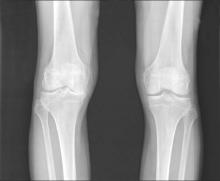A 6-week protocol of optimized analgesia followed by a 12-week exercise program significantly improved pain and functional limitations for patients with knee osteoarthritis, researchers reported in Arthritis Care and Research.
The study was the first to explore how to achieve sufficient pain relief for patients with severely painful knee OA to participate in exercise therapy, and it achieved that goal for 78% of patients, said Joyce van Tunen of the Amsterdam Rehabilitation Center and associates. “The newly developed intervention protocol was feasible, which means that patients were able to participate in exercise therapy despite their severe pain at baseline,” the researchers said. “Although the results are promising, they need to be confirmed in a randomized controlled trial.”
Guidelines recommend combining pharmacologic and nonpharmacologic modalities to improve osteoarthritis outcomes, and past studies have suggested that acetaminophen, NSAIDs, and glucosamine therapy might augment the benefits of exercise in OA, they said.
The study included 49 patients with severe knee OA whose pain scored at least 7 on a 10-point scale. Patients received standardized analgesia with acetaminophen and then were stepped up to NSAIDs, weak opioids, and intra-articular steroid injections if their pain did not improve to a 5 or lower. Patients had 2 weeks to adapt to each new prescription without further changes, and their doses were cut if they maintained pain scores of 4 or less for a month or longer. The protocol was based on the World Health Organization analgesic ladder and the Beating osteoARThritis strategy for stepped care in hip and knee OA, the investigators noted (Arthritis Care Res. 2015 Aug 3 doi: 10.1002/acr.22682).
After 6 weeks, patients continued with analgesia and started a 12-week exercise program of two 60-minute sessions per week. The first 6 weeks of the program focused on muscle strength, while the last 6 weeks aimed to maximize strength while adding functional and aerobic exercises. Patients also were asked to do physical therapy exercises at home on the days they did not take part in supervised exercise, the researchers said.
At the end of the 18-week intervention, 72% of patients reported improvement on a combined global scale, the study showed. Average pain scores improved by 30% (P < .001) and activity limitations improved by 17% (P < .001). Fully 78% of patients were able to follow the exercise program, and these patients improved their physical limitations by an extra 10% (P = .004), compared with patients who could not complete the program. Patients who were not able to finish the exercise program also had significantly worse radiographic signs of OA, compared with the others (P = .03), and tended to be younger; had higher body mass indices; and reported more pain, anxiety, and depression, the researchers said. These patients might need surgical interventions or therapy to help them learn to better cope with pain, they added.
Most of the patients had used analgesics irregularly and at suboptimal doses at baseline, in part because they feared adverse effects. However, they experienced no serious side effects from the analgesia protocol or the exercise program, the investigators noted.
The Dutch Arthritis Association funded the work. The investigators reported having no conflicts of interest.



